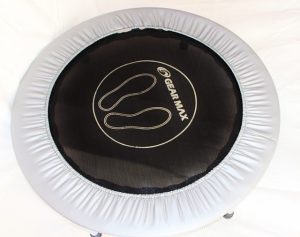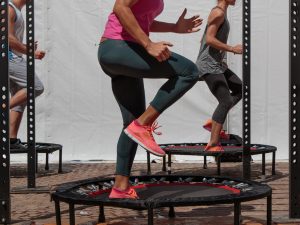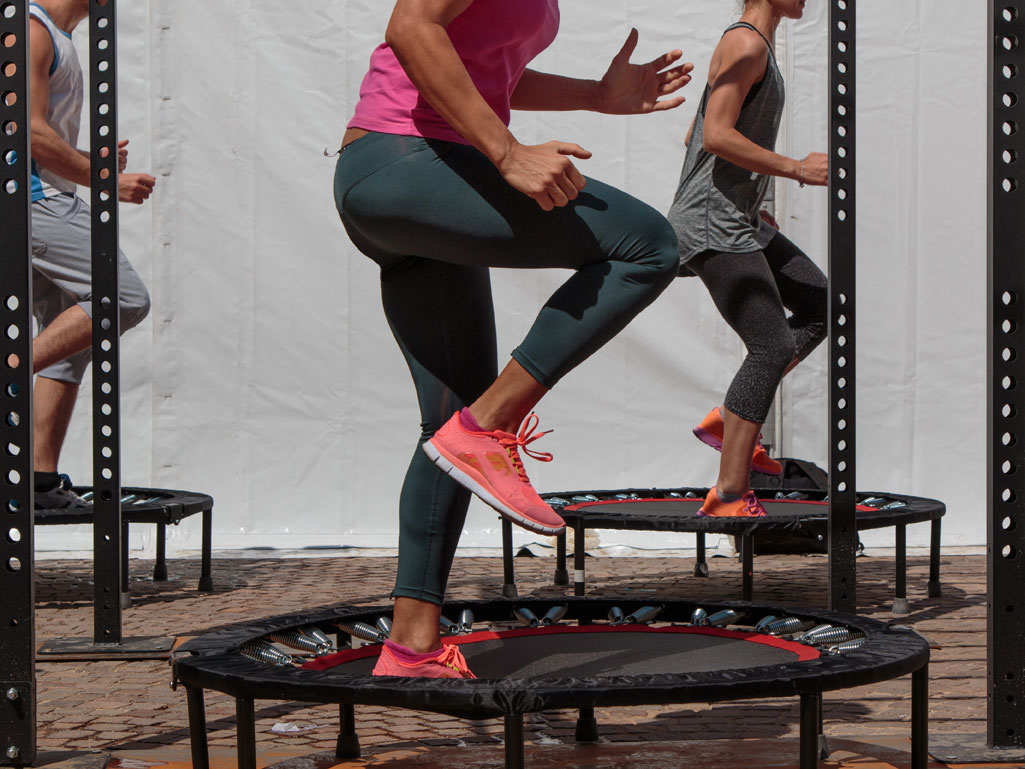Rebounding and Lymphedema
Rebounding is a complete cellular exercise, stimulating the activity of the lymphatic system (a critical part of the immune system). Rebounding 3-5 times per week at a minimum of 10-15 minutes at a time is highly beneficial.* It is effective at a minimal bounce, using acceleration and deceleration, with each bounce, to open and close the one-way valves between the lymphatic system and the cells. Lymphatic fluid surrounds all of the cells of the body. While bounding toxins, poisons, and metabolic waste are pulled out of the cells into the lymph fluid, while oxygen and nutrients (transferred previously at the capillaries, from the blood) are pulled in the cells from the lymph fluid. Within the lymph system are lymphocytes, for example- white blood cells, which consume metabolic waste, bacteria, and dead cells. Rebounding keeps the lymph system moving and unplugged, so lymphocytes have free reign to do their job. More importantly, bounding does this without stressing the hips, knees, or ankles, or creating shin-splints. It can be done on a daily basis or multiple times per day without creating overuse injury.
 What is the Lymph System and how does it help me?
What is the Lymph System and how does it help me?
The lymphatic system acts as a secondary circulatory system, except that it collaborates with white blood cells in lymph nodes to protect the body from being infected by cancer cells, fungi, viruses or bacteria.
The lymphatic system is a system of thin tubes that runs throughout the body. These tubes are called ‘lymph vessels’.
Unlike the circulatory system, the lymphatic system is not closed and has no central pump. It is not under pressure and only moves because of exercise or muscle contraction.
When the lymphatic system is congested, the cells become deprived of oxygen, affecting the body’s ability to rid itself of its own waste material. Over time, other body systems that rely on the lymphatic
It takes only two minutes of rebounding to flush the entire lymphatic system, while cleansing and strengthening cells and lymph nodes. A further benefit to the body is that during this brief time span the white blood cells of the immune system triple in number and remain elevated for an hour. These specialized cells play a major role in the body’s defense against illness and disease.
At this point another two-minute rebound session would increase the demand for white blood cells as the process of cleansing, strengthening, and the flushing away of spent cells and other cancerous debris is repeated.
When beginning a program of regular rebounding it’s best to gradually increase time and intensity as the body – including bones and internal organs – adjusts to the increased gravitational load and becomes stronger.
12 Reasons to Jump for your Health & Fitness
- Rebounding provides an increased G-force (gravitational load), which strengthens the musculoskeletal systems.
- Rebounding aids lymphatic circulation by stimulating the millions of one-way valves in the lymphatic system. Your lymphatic system acts as your body’s internal vacuum cleaner.
- Rebounding circulates more oxygen to the tissues- and where the is oxygen there cannot be disease.
- Rebounding establishes a better equilibrium between the oxygen required by the tissues and the oxygen made available.
 Rebounding increases capacity for respiration
Rebounding increases capacity for respiration- Rebounding increases the functional activity of the red bone marrow in the production of red blood cells.
- Rebounding improves resting metabolic rate so that more calories are burned for hours after exercise.
- Rebounding improves circulation. It encourages collateral circulation (the formation of new branch blood vessels that distribute blood to the heart) by increasing the capillary count in the muscles and decreasing the distance between the capillaries and the target cells.
- Rebounding strengthens the heart and other muscles in the body so that they work more efficiently.
- Rebounding improves coordination between the proprioceptors in the joints, the transmission of nerve impulses to and from the brain, transmission of nerve impulses and responsiveness of the muscle fibers.
- Rebounding improves the brain’s responsiveness to the vestibular apparatus within the inner ear, thus improving balance.
- Rebounding for longer than 20 minutes at a moderate intensity increases the mitochondria count within the muscle cells, essential for endurance.
- As our planet has become dangerously congested with debris so does our body. We are neither helpless nor hopeless in this dire state; we can also take measures to reduce, eliminate and cleanse toxins from the blood, tissues and organs of our bodies. One of several effective methods of detoxification is through lymphatic cleansing.
Among the various functions of the lymphatic system is its ability to carry waste away from the cells and bloodstream to the body’s organs of elimination. The system consists of veins and capillaries, with one-way valves, that contain a clear fluid called lymph. This fluid also surrounds cells throughout the body and collects cellular debris before draining it into the lymphatic system. Lymph carries the waste on a one-way path toward the heart and passes through many filters (lymph nodes) where special white blood cells attack and eliminate foreign molecules.
Once the lymph fluid approaches the heart it is returned to circulation and makes its way for further cleansing of toxins by the liver and kidneys. The lymphatic vessels are not connected to the blood circulatory system, and unlike blood which is pumped by the heart, lymph fluid relies on bodily movement and exercise to drive it through the lymphatic system. Forceful flushing of the system cleanses lymph nodes, contributes to healthy, clear lymph fluid, and boosts the immune system. Stagnant, slow-moving and thick lymph fluid is due to a lethargic, toxic body and weakened immune system.
When the lymph fluid remains sluggish the lymph nodes become clogged and lose their filtering ability. Without routine flushing of the lymph, debris becomes trapped in the body, creating a toxic overload and contributing to the onset of disease.
 It takes only two minutes of rebounding to flush the entire lymphatic system, while cleansing and strengthening cells and lymph nodes. A further benefit to the body is that during this brief time span the white blood cells of the immune system triple in number and remain elevated for an hour. These specialized cells play a major role in the body’s defense against illness and disease.
It takes only two minutes of rebounding to flush the entire lymphatic system, while cleansing and strengthening cells and lymph nodes. A further benefit to the body is that during this brief time span the white blood cells of the immune system triple in number and remain elevated for an hour. These specialized cells play a major role in the body’s defense against illness and disease.
At this point another two-minute rebound session would increase the demand for white blood cells as the process of cleansing, strengthening, and the flushing away of spent cells and other cancerous debris is repeated.. Therapeutic rebounding has been shown to reduce cancerous tumors and improve or heal a host of other ailments (3).
When beginning a program of regular rebounding it’s best to gradually increase time and intensity as the body – including bones and internal organs – adjusts to the increased gravitational load and becomes stronger.
Doreen Puglisi, MS is the Founder and Executive Director of Pink Ribbon Program. The Pink Ribbon program works to give every woman the ability to regain a sense of well-being that had been lost from diagnosis through surgery into recovery.
References:
- Brooks, Linda: Rebounding and Your Immune System. Urbana, OH: Vitally Yours Press, 29; 33-46, 2003
- Brooks, Linda: Cancer – A Simple Approach. Urbana, OH: Vitally Yours Press, 33-6, 2002
- Brooks, Linda: Rebounding to Better Health. Sixth Printing, KE Publishing, 51-2; 39-56; 71-6, 2006




